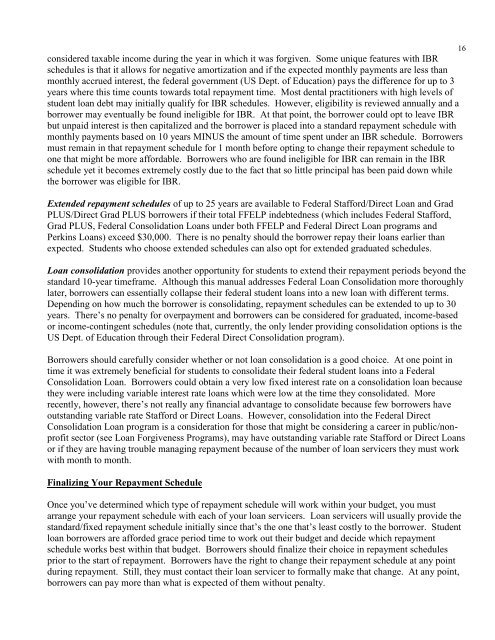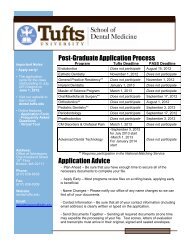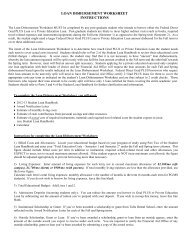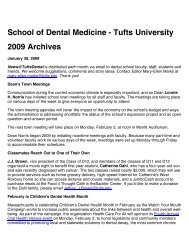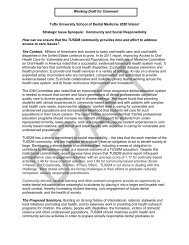student loan repayment manual table of contents - Tufts University
student loan repayment manual table of contents - Tufts University
student loan repayment manual table of contents - Tufts University
You also want an ePaper? Increase the reach of your titles
YUMPU automatically turns print PDFs into web optimized ePapers that Google loves.
considered taxable income during the year in which it was forgiven. Some unique features with IBRschedules is that it allows for negative amortization and if the expected monthly payments are less thanmonthly accrued interest, the federal government (US Dept. <strong>of</strong> Education) pays the difference for up to 3years where this time counts towards total <strong>repayment</strong> time. Most dental practitioners with high levels <strong>of</strong><strong>student</strong> <strong>loan</strong> debt may initially qualify for IBR schedules. However, eligibility is reviewed annually and aborrower may eventually be found ineligible for IBR. At that point, the borrower could opt to leave IBRbut unpaid interest is then capitalized and the borrower is placed into a standard <strong>repayment</strong> schedule withmonthly payments based on 10 years MINUS the amount <strong>of</strong> time spent under an IBR schedule. Borrowersmust remain in that <strong>repayment</strong> schedule for 1 month before opting to change their <strong>repayment</strong> schedule toone that might be more affordable. Borrowers who are found ineligible for IBR can remain in the IBRschedule yet it becomes extremely costly due to the fact that so little principal has been paid down whilethe borrower was eligible for IBR.Extended <strong>repayment</strong> schedules <strong>of</strong> up to 25 years are available to Federal Stafford/Direct Loan and GradPLUS/Direct Grad PLUS borrowers if their total FFELP indebtedness (which includes Federal Stafford,Grad PLUS, Federal Consolidation Loans under both FFELP and Federal Direct Loan programs andPerkins Loans) exceed $30,000. There is no penalty should the borrower repay their <strong>loan</strong>s earlier thanexpected. Students who choose extended schedules can also opt for extended graduated schedules.Loan consolidation provides another opportunity for <strong>student</strong>s to extend their <strong>repayment</strong> periods beyond thestandard 10-year timeframe. Although this <strong>manual</strong> addresses Federal Loan Consolidation more thoroughlylater, borrowers can essentially collapse their federal <strong>student</strong> <strong>loan</strong>s into a new <strong>loan</strong> with different terms.Depending on how much the borrower is consolidating, <strong>repayment</strong> schedules can be extended to up to 30years. There’s no penalty for overpayment and borrowers can be considered for graduated, income-basedor income-contingent schedules (note that, currently, the only lender providing consolidation options is theUS Dept. <strong>of</strong> Education through their Federal Direct Consolidation program).Borrowers should carefully consider whether or not <strong>loan</strong> consolidation is a good choice. At one point intime it was extremely beneficial for <strong>student</strong>s to consolidate their federal <strong>student</strong> <strong>loan</strong>s into a FederalConsolidation Loan. Borrowers could obtain a very low fixed interest rate on a consolidation <strong>loan</strong> becausethey were including variable interest rate <strong>loan</strong>s which were low at the time they consolidated. Morerecently, however, there’s not really any financial advantage to consolidate because few borrowers haveoutstanding variable rate Stafford or Direct Loans. However, consolidation into the Federal DirectConsolidation Loan program is a consideration for those that might be considering a career in public/nonpr<strong>of</strong>itsector (see Loan Forgiveness Programs), may have outstanding variable rate Stafford or Direct Loansor if they are having trouble managing <strong>repayment</strong> because <strong>of</strong> the number <strong>of</strong> <strong>loan</strong> servicers they must workwith month to month.Finalizing Your Repayment ScheduleOnce you’ve determined which type <strong>of</strong> <strong>repayment</strong> schedule will work within your budget, you mustarrange your <strong>repayment</strong> schedule with each <strong>of</strong> your <strong>loan</strong> servicers. Loan servicers will usually provide thestandard/fixed <strong>repayment</strong> schedule initially since that’s the one that’s least costly to the borrower. Student<strong>loan</strong> borrowers are afforded grace period time to work out their budget and decide which <strong>repayment</strong>schedule works best within that budget. Borrowers should finalize their choice in <strong>repayment</strong> schedulesprior to the start <strong>of</strong> <strong>repayment</strong>. Borrowers have the right to change their <strong>repayment</strong> schedule at any pointduring <strong>repayment</strong>. Still, they must contact their <strong>loan</strong> servicer to formally make that change. At any point,borrowers can pay more than what is expected <strong>of</strong> them without penalty.16


